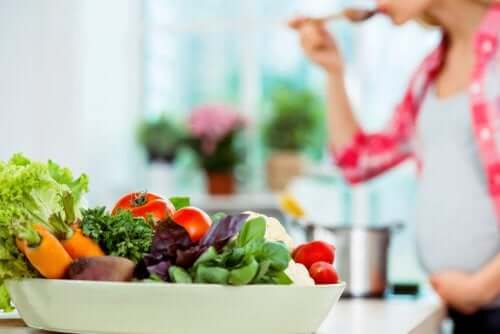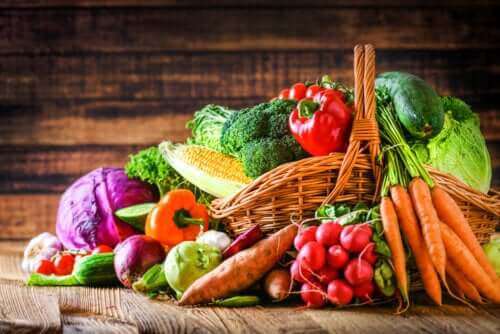How to Make Vegetables Taste Good


Written and verified by the nutritionist Silvia Zaragoza
Do you remember the first time you ate vegetables? Did you like them? Of course, it depends on the type of vegetable you ate and the way it was cooked. That’s why today, we’d like to teach you how to make vegetables taste good, so that you and your family, especially your children, will enjoy eating them.
Why don’t you or your family like vegetables?
Have you ever wondered about this? Food preferences develop during childhood and change over the years. First, make a list of all the vegetables you don’t like (you can write all of them), because context is very important.
Next, we’ll show two different situations that may have made you avoid them. The first one is when you used to eat them with your parents. When you ate vegetables for the first time, you probably didn’t like them. This usually happens when you eat something new. You might not be used to certain tastes, unless your mother ate vegetables during her pregnancy.
This is known as neophobia. And, this is why you had to give vegetables another try. Then, when your parents put vegetables in your plate you reacted in different ways. Try to remember what they did to make you eat them. Maybe, they forced you or they promised a reward in exchange. If any of this happened to you, there you have a reason.

Another situation that made you avoid them is the negative connotation behind vegetables by being associated to different diets. It all began during the 1980s, when diets were all about cooked vegetables or salads, plus something grilled.
Nevertheless, diet is a lifestyle. Besides, vegetables are necessary in a healthy meal and there are many ways to eat them, intensifying their flavor. How can you do that? You must follow certain cooking methods and cutting techniques, and combine them with other food. Next, we’ll tell you how you can make vegetables taste good.
How to make vegetables taste good
Use herbs and spices to cook your vegetables
Herbs and spices are good to replace salt, while also appealing to children’s palates. Adults will also like them better. At least, this was confirmed by different scientific studies, such as Spice MyPlate, where urban teenagers from Baltimore learned about nutrition for six months.
The aim was to promote healthy food through cooking lessons. They also learned to use spices and to shop for healthy food. In the long term, they ended up increasing vegetable consumption and they became more conscious regarding healthy food.
Furthermore, spices reduce the bitterness of certain vegetables, such as broccoli, Brussels sprouts, etc. This is quite useful for people sensitive to this taste, due to the presence of the PROP gene, according to several studies.
However, the palate needs to get used to the taste of herbs and spices. When testing rural teenagers, they preferred vegetables with nothing but salt. Combining herbs and spices with the right vegetable is also important.
Stir-fry your vegetables with nuts
In our opinion, this is the best way to cook them. Don’t boil them anymore. Just stir-fry them using a bit of oil, to keep them from sticking to the pan. First cook your vegetables, then add the nuts and let them toast.

Remember to stir and check constantly. Try using raisins and pine nuts! Or chop walnuts and almonds with parsley and lemon zest. You can also use garlic and sweet paprika.
Try different food presentations
Sight and smell are the two senses that first activate before eating. This is why food should be appealing. You can do this by:
- Combining different colors (red, orange, yellow, green, purple)
- Chopping them in different shapes, like sticks, circles, dices, etc. You’ll see how the taste changes.
- Using different cooking methods to maintain the flavor and nutrients. You can cook them in the oven, steam, grill, sautée, puree or keep raw.
Finally, remember that vegetables are a healthy food, but you need to use them properly. In the end, you’ll learn to appreciate them and also become used to eating them to your liking.
Do you remember the first time you ate vegetables? Did you like them? Of course, it depends on the type of vegetable you ate and the way it was cooked. That’s why today, we’d like to teach you how to make vegetables taste good, so that you and your family, especially your children, will enjoy eating them.
Why don’t you or your family like vegetables?
Have you ever wondered about this? Food preferences develop during childhood and change over the years. First, make a list of all the vegetables you don’t like (you can write all of them), because context is very important.
Next, we’ll show two different situations that may have made you avoid them. The first one is when you used to eat them with your parents. When you ate vegetables for the first time, you probably didn’t like them. This usually happens when you eat something new. You might not be used to certain tastes, unless your mother ate vegetables during her pregnancy.
This is known as neophobia. And, this is why you had to give vegetables another try. Then, when your parents put vegetables in your plate you reacted in different ways. Try to remember what they did to make you eat them. Maybe, they forced you or they promised a reward in exchange. If any of this happened to you, there you have a reason.

Another situation that made you avoid them is the negative connotation behind vegetables by being associated to different diets. It all began during the 1980s, when diets were all about cooked vegetables or salads, plus something grilled.
Nevertheless, diet is a lifestyle. Besides, vegetables are necessary in a healthy meal and there are many ways to eat them, intensifying their flavor. How can you do that? You must follow certain cooking methods and cutting techniques, and combine them with other food. Next, we’ll tell you how you can make vegetables taste good.
How to make vegetables taste good
Use herbs and spices to cook your vegetables
Herbs and spices are good to replace salt, while also appealing to children’s palates. Adults will also like them better. At least, this was confirmed by different scientific studies, such as Spice MyPlate, where urban teenagers from Baltimore learned about nutrition for six months.
The aim was to promote healthy food through cooking lessons. They also learned to use spices and to shop for healthy food. In the long term, they ended up increasing vegetable consumption and they became more conscious regarding healthy food.
Furthermore, spices reduce the bitterness of certain vegetables, such as broccoli, Brussels sprouts, etc. This is quite useful for people sensitive to this taste, due to the presence of the PROP gene, according to several studies.
However, the palate needs to get used to the taste of herbs and spices. When testing rural teenagers, they preferred vegetables with nothing but salt. Combining herbs and spices with the right vegetable is also important.
Stir-fry your vegetables with nuts
In our opinion, this is the best way to cook them. Don’t boil them anymore. Just stir-fry them using a bit of oil, to keep them from sticking to the pan. First cook your vegetables, then add the nuts and let them toast.

Remember to stir and check constantly. Try using raisins and pine nuts! Or chop walnuts and almonds with parsley and lemon zest. You can also use garlic and sweet paprika.
Try different food presentations
Sight and smell are the two senses that first activate before eating. This is why food should be appealing. You can do this by:
- Combining different colors (red, orange, yellow, green, purple)
- Chopping them in different shapes, like sticks, circles, dices, etc. You’ll see how the taste changes.
- Using different cooking methods to maintain the flavor and nutrients. You can cook them in the oven, steam, grill, sautée, puree or keep raw.
Finally, remember that vegetables are a healthy food, but you need to use them properly. In the end, you’ll learn to appreciate them and also become used to eating them to your liking.
All cited sources were thoroughly reviewed by our team to ensure their quality, reliability, currency, and validity. The bibliography of this article was considered reliable and of academic or scientific accuracy.
- D’Adamo, C.R; McArdle, P. F; Balick, L; Peisach, E; Ferguson, T; Diehl,A et al. (2016) Spice MyPlate: Nutrition Education Focusing Upon Spices and Herbs Improved Diet Quality and Attitudes Among Urban High School Students. Am J Health Prom, 30(5): 346-56.
- Feng Y, Albiol Tapia M, Okada K, Castaneda Lazo NB, Chapman-Novakofski K, Phillips C et al. (2018) Consumer acceptance comparison between seasoned and unseasoned vegetables. J Food Sci, 83(2): 446-53.
- Manero J, Phillips C, Ellison B, Lee SY, Nickols-Richardson SM, Chapman-Novakofski KM. (2017) Influence of seasoning on vegetable selection, liking and intent to purchase. Appetite, 116:239-45.
- Fritts JR, Bermudez MA, Hargrove RL, Alla L, Fort C, Liang Q et al. (2019). Using Herbs and Spices to Increase Vegetable Intake Among Rural Adolescents. J Nutr Educ Behav, 51(7): 806-16.
- Carney EM, Stein WM, Reigh NA, Gater FM, Bakke AJ, Hayes JE et al. (2018). Increasing flavor variety with herbs and spices improves relative vegetable intake in children who are propylthiouracil (PROP) tasters relative to nontasters. Physiol Behav, 188:48-57.
- Basulto, J; Moñino, M; Farran, A; Baladia, E; Manera, M; Cervera, P et al. (2014). Recomendaciones de manipulación doméstica de frutas y hortalizas para preservar su valor nutritivo. Rev Esp Nutr Hum Diet, 18 (2), 100-15.
This text is provided for informational purposes only and does not replace consultation with a professional. If in doubt, consult your specialist.








